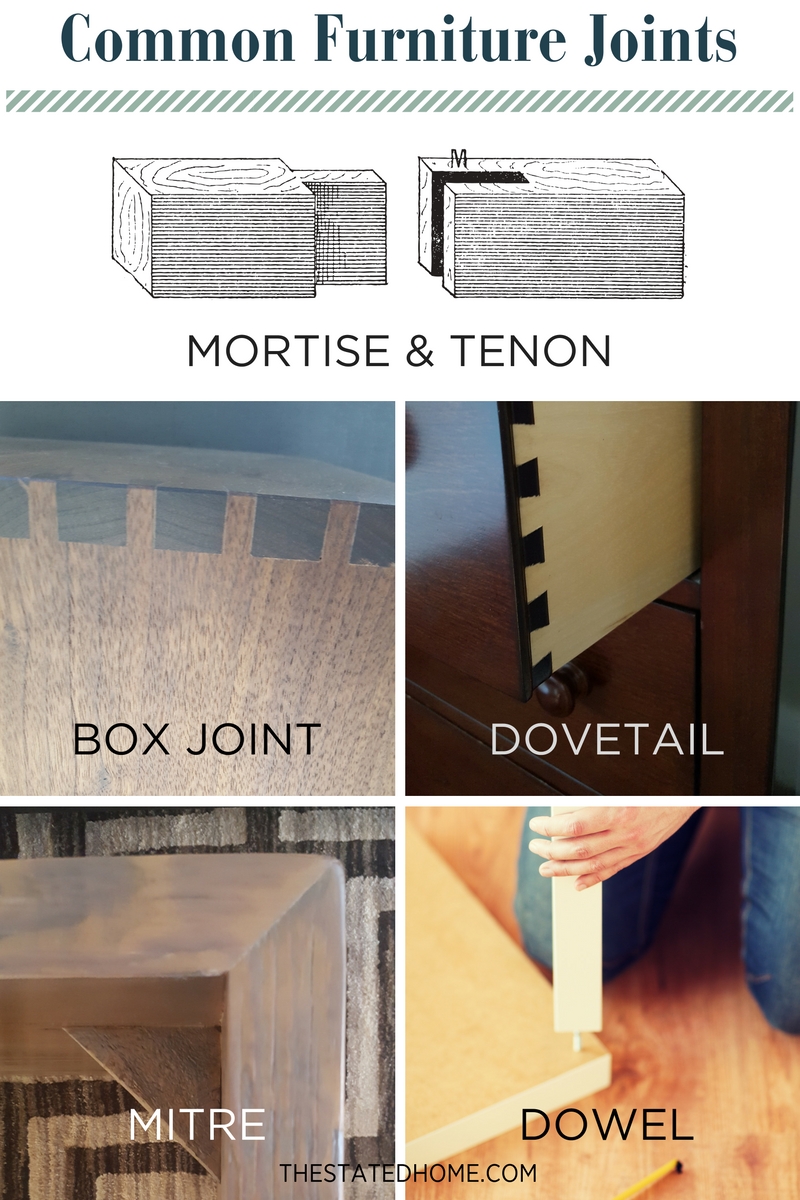When you’re talking about wood furniture, joinery is how the pieces of wood are connected to each other. If done well, it can create a stable piece. If don’t poorly, you’ll have a wobbly table in the not-so-distant future.
If you’ve ever assembled a piece of flat-packed furniture from Ikea or Target, you’ve actually participated in the process of furniture joinery (and you’ve probably discovered that kind of joinery isn’t the best if you want a sturdy final product). There is a great explanation of furniture joinery here, but we wanted to give you a quick rundown of what to look for and what to avoid. Keep reading to find out more about joinery (and check out our selection of gorgeous wood furniture here).
Good Joinery Types
- Rabbet (or Rebate) and Dado: A piece of wood (called a rabbet) is inserted into a groove (that’s the dado) and is reinforced with glue. This is a common and extremely strong way to join two pieces of wood—it’s often used for joining together large boards like those used in a cabinet, dresser, or bookcase.
- Mortise and Tenon: A part of one piece of wood (the tenon) is inserted into a precise hole on a second piece of wood (known as the mortise) and reinforced with glue. Also common and very strong, this joinery method is used to attach narrower pieces of wood, like connecting a chair leg to a chair seat.
- Box Joint: Two boards are connected at a corner by using interlacing notches and glue. The notches provide a large surface area for the glue to adhere to, resulting in a strong joint. This is a fun decorative way to join two pieces of wood, since you can see the joints.
- Dovetail: This method is similar to a box joint, but with notches in the shape of a trapezoid. This is the best method for constructing drawers, since the side pieces won’t slide out of the front or back piece.
- French or Sliding Dovetail: Another way of constructing drawers, this dovetail is made by a long trapezoid shape that slides into a groove on the drawer front. It’s also a very good way of constructing drawers since the shape prevents the pieces from coming apart.
- Dowel Joint: A dowel joint is made by drilling holes in the pieces of wood to be joined and inserting a round peg into the holes with glue. This joint can be very strong if done correctly (but unfortunately, poorly done dowel joints are common). If you’re buying a more expensive piece of furniture that uses this method, it’s most likely done well (with at least two dowels at each joint). Inexpensive furniture (especially those made of MDF or particle board) usually have just one dowel and don’t usually reinforce it with glue. The result: pieces that get wobbly real fast.
- Mitre Joint: Two pieces of wood are cut at a 45-degree angle and joined using glue, nails, or screws. This joint is not super strong, but it’s acceptable for non-structural pieces like moldings or picture frames or when reinforced with corner blocks.
Joinery to Avoid
- Butt Joint: Two pieces of wood are joined together at a 90-degree angle without any notching. It is attached only using glue, screws, or nails or some combination of those. This is the weakest type of joint and it should be avoided in furniture.
- Biscuit Joint: This is similar to a dowel joint, except instead of a cylinder being inserted in a hole, a thin disk is inserted into a slot. Biscuits are useful for aligning pieces of wood (say if you were joining narrow boards to make a table top), but not good for structural joints.
- Dowel Joint: Like we said above, avoid this method if joints rely on a single dowel.
Corner Blocks: A Sturdy Piece of Furniture’s Best Friend
A corner block is a wood “bracket” that gets screwed into both pieces of wood at a corner. This provides an extra boost of stability in case the initial joint ever loosens up. This is especially important on pieces that get a lot of use and are prone to wobble—we’ve all sat on a shaky dining chair before!
How to Shop for Furniture Joinery
- Look at the underside of tabletops to see if there is corner reinforcement
- Drawer construction should show dovetail joinery or French dovetail joinery
- You should not see glue seeping out of joints
- Avoid dowel joinery if it is a single dowel or doesn’t use glue as reinforcement
Joinery is only one of the things you should look for when shopping for wood furniture. Check out our other blogs on wood types, veneers, and finishes to get a complete picture.
Like what you read? Visit thestatedhome.com to shop our collection of made-in-America furnishings.


Thanks for the information non joinery. My wife and I are going to have new joints put in our kitchen, and we are trying to decide on a material. I like that you mentioned that a box joint is a good way to connect wood because you can see the joints. That could provide a cool and interesting look to the wood. I will have to look into it and see if it will work for us.